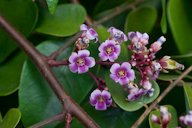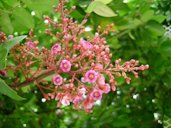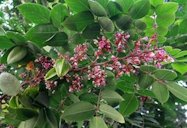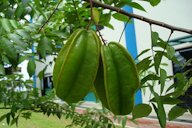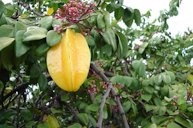| Carambola - Averrhoa carambola | |||||||||||||||||||||||||||||||||
|---|---|---|---|---|---|---|---|---|---|---|---|---|---|---|---|---|---|---|---|---|---|---|---|---|---|---|---|---|---|---|---|---|---|
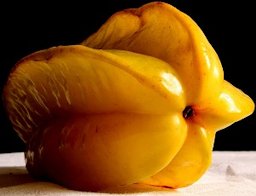 Fig. 1  Averrhoa carambola 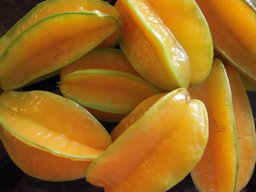 Fig. 2  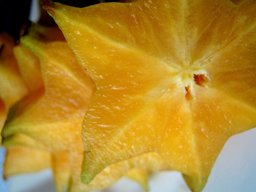 Fig. 3  Kamrakh A. carambola in Kolkata, West Bengal, India  Fig. 4  Stages of ripeness 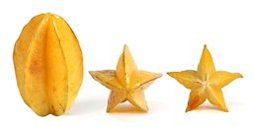 Fig. 5  Vertical view, side and cross section profiles 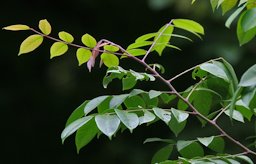 Fig. 6  Leaf habit 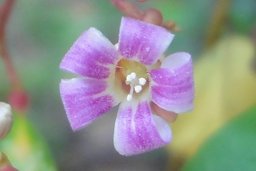 Fig. 7  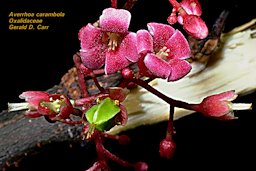 Fig. 8  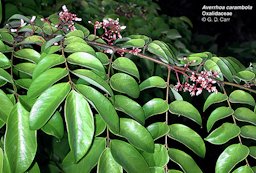 Fig. 12  A. carambola, Oxalidaceae, flower habit  Fig. 13  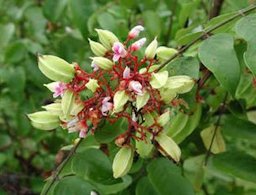 Fig. 14 Fruit forming 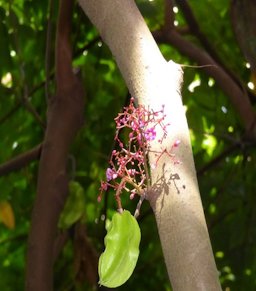 Fig. 15  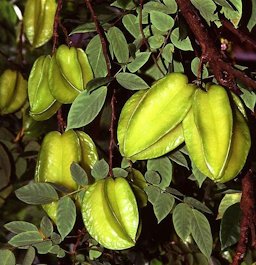 Fig. 16  'Arkin' variety, unripe fruit 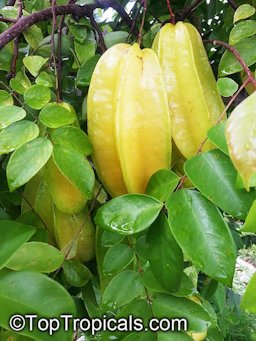 Fig. 20   Fig. 21  Different stages of ripening for 'Kajang' variety 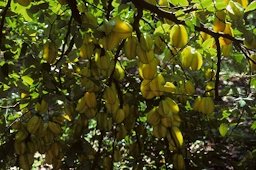 Fig. 22 Carambola trees are very prolific 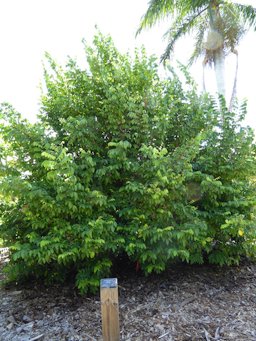 Fig. 23  Carambola 'Fwang Tung', Palma Sola Botanical Park 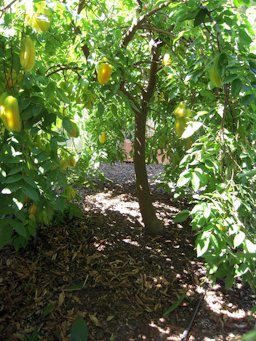 Fig. 26  Carambola fruit grows under the canopy; clear an area to be able to check on the ripening of your fruit 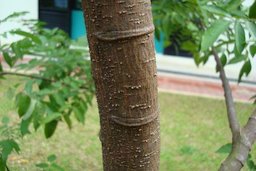 Fig. 27  Carambola trunk of a young tree 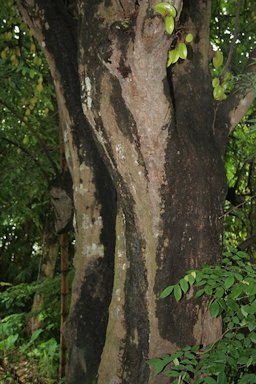 Fig. 28  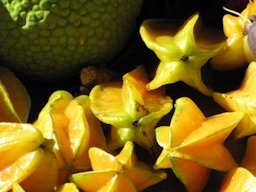 Fig. 29  A. carambola (Star fruit, carambola). Fruit from Pali o Waipio at Hawea Pl Olinda, Maui, Hawai'i. 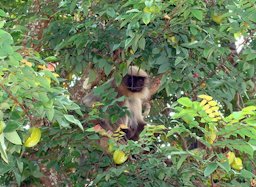 Fig. 30  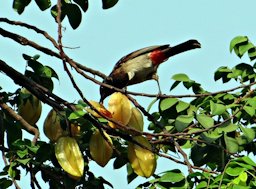 Fig. 31  Red Vented Bulbul feasting on carambola 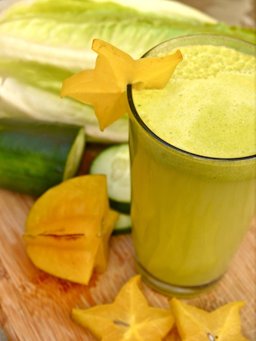 Fig. 32 Sunday squeeze: starfruit juice  Fig. 33  Salada para qualquer temperatura |
Scientific
name Averrhoa carambola L. Common names English: foreign peach, carambola, five corners, star pickle, star fruit, Chinese star fruit, five angled fruit; Creole: blinblin long, ziblinn long, karambola, kònichon peyi; Filipino: balimbing; French: cornichon du pays, blinblin longue, carambolier, carambolier vrai; German: Karambolaßaum; Hindi: kamrakh, kamranga; Indonesian: belimbing manis; Khmer: spö; Lao, Sino-Tibetan: füang; Malay: belimbing manis; Mandarin: yongt’o; Spanish: carambolera, carambole, árbol de pepino 4 Synonyms A. acutangula Stokes; Sarcotheca philippica (Villar) Hallier f. 8 Relatives Bilimbi (A. bilimbi L.) Family Oxalidaceae (wood-sorrel family) Origin Southeast Asia Uses Fresh fruit; landscape value for foliage, flowers and unusual fruit shape Height 22-33 ft (7-10 m) Spread 20-25 ft diameter (6-7.6 m) Crown Bushy canopy; broad; round Plant habit Small evergreen tree; symmetrical shape Growth rate Fast if in a location protected from winds Longevity Relatively long-lived; 10 year old trees bear heavy crops Trunk/bark/branches Single or multi-trunked; weepin habit Pruning requirement Selective pruning to maintain tree at 6-12 ft (1.8-3.6 m); culling will yield larger fruit Leaves Edible; evergreen; compound 6-12 in. (15-30 cm); arranged alternately on branch; each has 5-12 leaflets Flowers Edible; small; rose colored; fragrant; flowers several times a year Fruit Yellow with wax-like surface; sides deeply ridged; cross section is star shaped; borne on trunk/branches Season Generally June-Feb.; peaks in fruit production Aug.-Sept., Dec.-Feb. 1 USDA Nutrient Content pdf Light requirement Sun or semi-shade Soil tolerances Adapted to many types of well drained soils pH preference 4.5-7.0 Drought tolerance Limited tolerance Flood tolerance Moderately tolerant of excessively wet or flooded soil conditions for about 2 to 10 days 1 Wind tolerance Intolerant Aerosol salt tolerance Intolerant Soil salt tolerance Intolerant Cold tolerance Trees generally stop growing at 65 °F (18 °C); mature trees may be killed at 20-24 °F (-6.6 to -4.4 °C) 1 Plant spacing 20-30 ft or more (7.6-9.1 m) Invasive potential * Not a problem species (un-documented) Pest resistance Carambola trees are attacked by a number of scale insects Known hazard People who have been diagnosed with kidney disease should not eat carambola (star fruit) unless their doctor says that it is safe for them to eat. This fruit may contain enough oxalic acid to cause a rapid decline in renal function. 1 Reading Material Carambola Growing in the Home Landscape, University of Florida pdf Carambola, Fruits of Warm Climates Carambola, California Rare Fruit Growers Averrhoa carambola, Agroforestree Database Carambola Could Be the New ‘Star’ of Florida Agriculture, Vegetable and Specialty Crop News Origin The carambola is believed to have originated in Ceylon and the Moluccas but it has been cultivated in southeast Asia and Malaysia for many centuries. 2 The generic name is after Averrhoes (1126-98), the widely known Arab Philosopher. The specific name, ‘carambola’, is said to have come from Malabar and was adopted early by the Portuguese. 4 Description The carambola tree is classified as an evergreen and is in the Oxalidaceae family. It is a plant that is indigenous to India and Southeast Asia and was first introduced into Florida over a century ago. The tree is small to medium in height (22 to 33 feet), has a spreading canopy, and is either single or multi-trunked. The majority of the fruit production occurs in the middle of the canopy. Compound leaves are alternate, with five to twelve leaflets per leaf. The fruit are star-shaped in cross section with generally five longitudinal ribs. Edible seeds encased in a gelatinous case are produced in the ribs. The star fruit berry may range from two to six inches in length, and does not produce sugar after picking. Consequently, sweetest fruit are tree-ripened. The crop is considered mature when the color begins to “break” from green to gold between the ribs. 3
Flowers Carambola flowers are borne on panicles on twigs, or small-diameter branches, and occasionally on larger wood. The flowers are perfect, small (3/8 inch or 1 cm in diameter) and pink to lavender in color. They have 5 petals and sepals. Depending upon the cultivar, carambola flowers have either long or short styles. 1
Flowering and Fruit Development, University of Florida Fruit The fruit is a fleshy, 4- to 5-celled berry with a waxy surface. Fruit are 2 to 6 inches (5-15 cm) in length, with 5 (rarely 4-8) prominent longitudinal ribs. They are star-shaped in cross section. The fruit skin is thin, light to dark yellow, and smooth, with a waxy cuticle. The pulp is light to dark yellow in color, translucent, crisp, very juicy, and without fiber. Desirable varieties have an agreeable, sub acid to sweet flavor. Fruit are sweetest when allowed to ripen on the tree. 1 The fruit is non-climacteric. Fruit Set in Carambola, Archives of the Rare Fruit Council of Australia Oxalic Acid Content of Carambola and Bilimbi, Archives of the Rare Fruit Council of Australia
Fig. 18. Unripe fruit, a relish may be made of chopped unripe fruits Fig. 19. Carambola ripe fruit, flowers and leaves Varieties There are 2 distinct classes of carambola–the smaller, very sour type, richly flavored, with more oxalic acid; the larger, so-called "sweet" type, mild-flavored, rather bland, with less oxalic acid. 2
Fig. 24. 'Sri Kembangan' carambola, Palma Sola Botanical Park Fig. 25. 'Kary' carambola tree habit Cultivars for Florida, University of Florida Carambola Varieties, Archives of the Rare Fruit Council of Australia Harvesting The mid-canopy area (3 to 7 ft high; 0.9 to 2.1 m) is the major fruit-producing area of mature trees. It takes about 60 to 75 days from fruit set to maturity depending upon variety, cultural practices, and weather. 1 Carambola trees grown in wind-protected areas may begin to produce fruit within 10 to 14 months after planting. Generally, 10 to 40 lbs (4.5 to 18 kg) of fruit per year per tree can be expected during the first two to three years. As trees mature, fruit production will increase rapidly so that by years 5 and 6, 100 to 150 lbs (45 to 68 kg) of fruit per tree can be expected. Mature trees 7 to 12 years old may produce 250 to 350 lbs (112 to 160 kg) of fruit or more per year. 1 Carambola: Postharvest Quality-Maintenance Guidelines, University of Hawai'i at Mānoa pdf Pollination All the flowers on a given carambola variety have either long or short styles; this condition is called heterostyly. Some carambola cultivars may require cross pollination (short-styled by long-styled cultivar or vice versa) for good fruit set and yields. However, varieties such as 'Fwang Tung', 'Golden Star' and 'Arkin' produce abundant crops when planted in solid blocks, indicating that the need for cross pollination by opposing stylar types is not always necessary. Other varieties such as 'B-10' and 'B-17' produce more fruit when cross pollinated with another variety. 1 Propagation Carambola cultivars are generally grafted on seedling rootstocks. Seedlings of 'Golden Star' appear to be better adapted to high-pH soils than are seedling rootstocks of 'Arkin'. Veneer grafting and chip budding during the time of most active growth have given good results. Actively growing, healthy carambola seedlings of ¼ inch in diameter (7 mm) are best for rootstocks. Graftwood should be taken from mature twigs on which leaves are still present and, if possible, when the buds are just beginning to grow. Alternatively, graftwood can be prepared 3 to 4 days ahead of grafting by removing the leaves. This will stimulate the buds to begin growing. 1 Pruning Carambola trees that are annually pruned to limit their tree size to 12 ft or less generally will survive hurricane force winds without toppling. 1 During the first 1 to 2 years after planting, young trees should be pruned by tipping shoots in excess of 2 to 3 ft to increase branching. If desired, trees may be trained to a modified central leader or open center configuration. Mature trees may be selectively pruned to maintain trees at 6 to 12 ft (1.8 to 3.6 m) in height. 1 Summer Practices Carambola trees are unique in that once a shoot and limb develop the ability to flower, they can flower repeatedly. Shoots gain the ability to flower after about 3 months. Pruning the willow-like long shoots (“whips”) or selecting a small diameter limb and removing all the lateral shoots from this limb to their bases will induce flowering in about 21 days and fruit approximately 70-80 days later. Flowering and fruiting may also be induced on whips by bending them from an upright position to a lateral position, clipping off the last 12 to 18 inches of growth, and clipping the leaves off but leaving a small (1/3 inch) piece of the petiole (leaf stem). 1
Winter Practices
Irrigation Young trees should be irrigated regularly to facilitate tree establishment and growth. Once trees begin to bear (1 to 2 years after planting), trees should be irrigated regularly from flowering through harvest. 1
Feritization Young trees should receive ¼ to ½ pound (113 to 226 g) of a mixed fertilizer containing nitrogen (N), phosphorus (P), potassium (K), and magnesium (Mg) every 30 to 60 days. As trees mature, the fertilizer rate should increase (1 to 5 lbs; 0.45 to 2.3 kg) with an application frequency of 4 to 6 times per year. 1 Iron deficiency may be corrected by 1 to 2 yearly soil applications of iron sulfate for trees growing in neutral or low-pH soils and 4 to 6 soil drench applications of chelated iron (specifically formulated for calcareous soils) to high-pH soils (pH above 7). 1
Pests Page Diseases Page Food Uses Ripe carambolas are eaten out-of-hand, sliced and served in salads, or used as garnish on avocado or seafood. They are also cooked in puddings, tarts, stews and curries. Carambola juice is served as a cooling beverage. To make jelly, it is necessary to use unripe "sweet" types or ripe sour types and to add commercial pectin or some other fruit rich in pectin such as green papaya, together with lemon or lime juice. The flowers are acid and are added to salads in Java; also, they are made into preserves in India. The leaves have been eaten as a substitute for sorrel. 2 Dehydrating Carambolas Carambola Recipes, Fairchild Tropical Botanic Garden Virtual Herbarium Carambola Recipes, Taste Florida's Tropics South Florida Tropicals: Carambola, University of Florida pdf (archived) Medicinal Properties ** In India, the ripe fruit is administered to halt hemorrhages and to relieve bleeding hemorrhoids; and the dried fruit or the juice may be taken to counteract fevers. A conserve of the fruit is said to allay biliousness and diarrhea and to relieve a "hangover" from excessive indulgence in alcohol. A salve made of the fruit is employed to relieve eye afflictions. In Brazil, the carambola is recommended as a diuretic in kidney and bladder complaints, and is believed to have a beneficial effect in the treatment of eczema. In Chinese Materia Medica it is stated, "Its action is to quench thirst, to increase the salivary secretion, and hence to allay fever." 2 Other Uses The acid types of carambola have been used to clean and polish metal, especially brass, as they dissolve tarnish and rust. The juice will also bleach rust stains from white cloth. Unripe fruits are used in place of a conventional mordant in dyeing. 2 General Schnebly’s Winery in the Redland makes a carambola wine that they say tastes like a Pinot Grigio. 5 No fruit tree provides greater near-term gratification than the carambola. It is precocious and bears abundantly over substantial portions of the year. The tree is handsome and is an appropriate size for most residential uses. The fruit should not be judged based on the sour, prematurely picked fruit sold by supermarkets. When harvested from a good cultivar at peak ripeness, the fruit is delicious: crisp, refreshing and laden with sweet juice. 9 Other Edible in the Averrhoa genus: Bilimbi, A. bilimbi Further Reading Crop Profile for Carambola in Florida, Southern Region IPM Center pdf Carambola Culture, Archives of the Rare Fruit Council of Australia The Carambola, Tropical Fruit News RFCI Carambola: A Star (Fruit) on the Wall, Fairchild Tropical Botanic Garden The Carambola, Manual Of Tropical And Subtropical Fruits Hey Carambola, Tropical Fruit News RFCI Carambola Tales, Tropical Fruit News RFCI Carambola Botanical Art List of Growers and Vendors |
||||||||||||||||||||||||||||||||
| Bibliography 1 Crane, Jonathan, H. "Carambola Growing in the Florida Home Landscape." Horticultural Sciences Dept., UF/IFAS Extension, HS12, Original pub. Aug. 1981, Revised Apr. 1994, Aug. 2005, May 2007, and Nov. 2016, Reviewed Dec. 2019, AskIFAS, edis.ifas.ufl.edu/mg269. Accessed 21 Apr. 2017, 5 Nov. 2020. 2 Fruits of Warm Climates. Julia F. Morton, Miami, 1987. 3 "Crop Profile for Carambola in Florida." Southern Region IPM Center, sponsored by the USDA National Institute of Food and Agriculture, Jan. 2014, ipmcenters.org. Accessed 8 June 2016. 4 Orwa C., et al. "Averrhoa carambola L." Agroforestree Database: a tree reference and selection guide, version 4.0, 2009, Agroforestry, www.worldagroforestry.org/treedb2/speciesprofile.php?Spid=267. Accessed 8 June 2016. 5 Ledesma, Noris. "Carambola: A Star (Fruit) on the Wall." Fairchild Tropical Botanic Garden, Miami Herald, 10 Mar. 2013, fairchildgarden.org. Accessed 8 June 2016. 6 Tasker, Georgia. "Starring a Winter Fruit." The Fairchild Blog, 18 Dec. 2012, fairchildgarden.org. Accessed 8 June 2016. 7 Dean, Green. "Edible Flowers: Part Seventeen." Eat the Weeds and other things, too. eatttheweeds.com. Accessed 16 June 2016. 8 "Averrhoa carambola L. synonyms." The Plant List (2013), Version 1.1, the plantlist.org. Accessed 16 June 2016. 9 Boning, Charles R. Florida's Best Fruiting Plants- Native and Exotic Trees, Shrubs, and Vines. Sarasota, Pineapple Press, 2006. Videos v1 "All About Carambola (Star Fruit)." Truly Tropical, 26 Aug. 2017, (CC0), www.youtube.com/watch?v=4SiCsOEl2ho. Accessed 30 Oct. 2021. v2 Crane, Jonathan, H., and Ian Maguire. "Demonstration Limb Bending and Summer Cultural Practices." University of Florida, 2009, IFAS/TREC. v3 Crane, Jonathan, H., and Ian Maguire. "Summer Crop." University of Florida, 2009, IFAS/TREC. v4 Crane, Jonathan, H., and Ian Maguire. "Insect Infestation and Winter Culture." University of Florida, 2009, IFAS/TREC. v5 Crane, Jonathan, H., and Ian Maguire. "Carambola Winter Crop." University of Florida, 2009, IFAS/TREC. v6 Crane, Jonathan, H., and Ian Maguire. "Irrigation." University of Florida, IFAS/TREC. v7 Crane, Jonathan, H., and Ian Maguire. "Strategy for Fertilizer." University of Florida, 2009, IFAS/TREC. v8 Crane, Jonathan, H., and Ian Maguire. "Discussion on Iron Deficiency." University of Florida, 2009, IFAS/TREC. Photographs Fig. 1 Storch, Hedwig. "Carambola Malysia." Wikimedia Commons, 2008, (CC BY-SA 3.0), commons.wikimedia.org. Accessed 18 June 2016. Fig. 2,4,15,22,23,24,25,26 Robitaille, Liette. "Carambola 'Kary' Series." 2014, www.growables.org. Fig. 3 Brunna F. "Carambolas!" Flickr, 2010, (CC BY-NC-SA 2.0), flickr.com. Accessed 20 June 2016. Fig. 6,28 Garg, J. M. I. "Kamrakh Averrhoa carambola in Kolkata, West Bengal, India." Wikimedia Commons, 2007, (CC BY-SA 3.0), GFDL, commons.wikimedia.org. Accessed 18 June 2016. Fig. 5 SMasters. "Ripe Carambolas, also known as starfruit, the fruit of Averrhoa carambola tree: vertical, side and cross section profiles. The fruit in cross section is a five-pointed star, hence its name." Wikimedia Commons, 2010, (CC BY-SA 3.0), commons.wikimedia.org. Accessed 25 Apr. 2016. Fig. 7,17,27 Kwan. "Averrhoa carambola." The Plant Observatory, 2008, www.natureloveyou.org. Accessed 25 Apr. 2016. Fig. 8,12 Carr, Gerald, D. "Averrhoa carambola Oxalidaceae." University of Hawai'i, Botany Department, Mānoa Campus Plants, botany.hawaii.edu. Accessed 3 Oct. 2014. Fig. 9 Hernandez, Andres. "Averrhoa carambola." Flickr, 2012, (CC BY-NC-SA 2.0), flickr.com. Accessed 20 June 2016. Fig. 10 Tauʻolunga. "Averrhoa carambola flowers; in Tonga." Wikimedia Commons, 2007, (CC BY-SA 3.0), GFDL, commons.wikimedia.org. Accessed 18 June 2016. Fig. 11 Sarangib, Bishnu. "Carambola inflorescense." Pixabay, 2013, Public Domain, pixabay.com. Accessed 18 June 2016. Fig. 13 "Averrhoa carambola." Top Tropicals, toptropicals.com. Accessed 30 Sept. 2014. Fig. 14,20 Maguire, Ian."'Kajang' carambola." Tropical Fruit Photography Picture Archive, 2000, UF/IFAS/TREC, trec.ifas.ufl.edu. Accessed 30 Sept. 2014. Fig. 16 Bauer, Scott. Carambolas, 'Arkin' variety." Wikimedia Commons, 2007, commons.wikimedia.org. Accessed 18 June 2016. Fig. 18 Rigmarole. "Carambola." Flickr, 2005, (CC BY-NC-SA 2.0), flickr.com. Accessed 20 June 2016. Fig. 19 Valll. "Carambola ripe fruit, flowers and leaves." Wikimedia Commons, 2007, commons.wikimedia.org. Accessed 18 June 2016. Fig. 21 Howard, R. A. "Averrhoa carambola L." National Museum of Natural History, Smithsonian Institution, mnh.si.edu. Accessed 18 June 2016. Fig. 29 Starr, Forest and Kim. "Averrhoa carambola (Star fruit, carambola). Fruit from Pali o Waipio at Hawea Pl Olinda, Maui, Hawaii." Flickr, 2012, (CC BY 2.0), flickr.com. Accessed 20 June 2016. Fig. 30 Sarangib, Bishnu. "Monkey and carambola." Pixabay, 2013, Public Domain, pixabay.com. Accessed 18 June 2016. Fig. 31 Sarangib, Bishnu. "Red Vented Bulbul feasting on carambola." Pixabay, 2014, Public Domain, pixabay.com. Accessed 18 June 2016. Fig. 32 Nicole. "Sunday Squeeze: Starfruit Juice." Pumps and Iron, 29 Sept. 2013, (CC BY-NC-ND 3.0), pumpsandiron.com/2013/09/29/sunday-squeeze-starfruit-juice/. Accessed 4 Nov. 2021. Fig. 33 Reis, Sandra. "Salada para qualquer temperatura." Receitas do Caldeirao, 3 June 2014, (CC BY-NC-SA 3.0 BR), www.caldeiraodabruxasolar.com/2014/06/salada-de-folhas-brotos-carambola-castanhas.html. Accessed 4 Nov. 2021. * UF/IFAS Assessment of Non-native Plants in Florida's Natural Areas ** Information provided is not intended to be used as a guide for treatment of medical conditions. Published 12 Apr. 2014 LR. Last update 16 Jan. 2022 LR |
|||||||||||||||||||||||||||||||||
